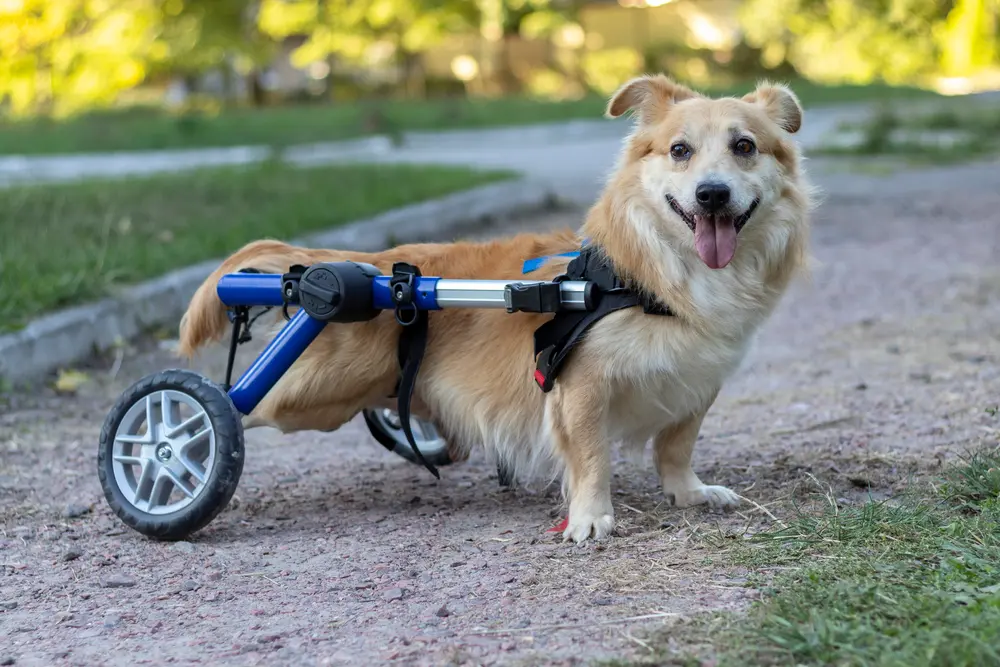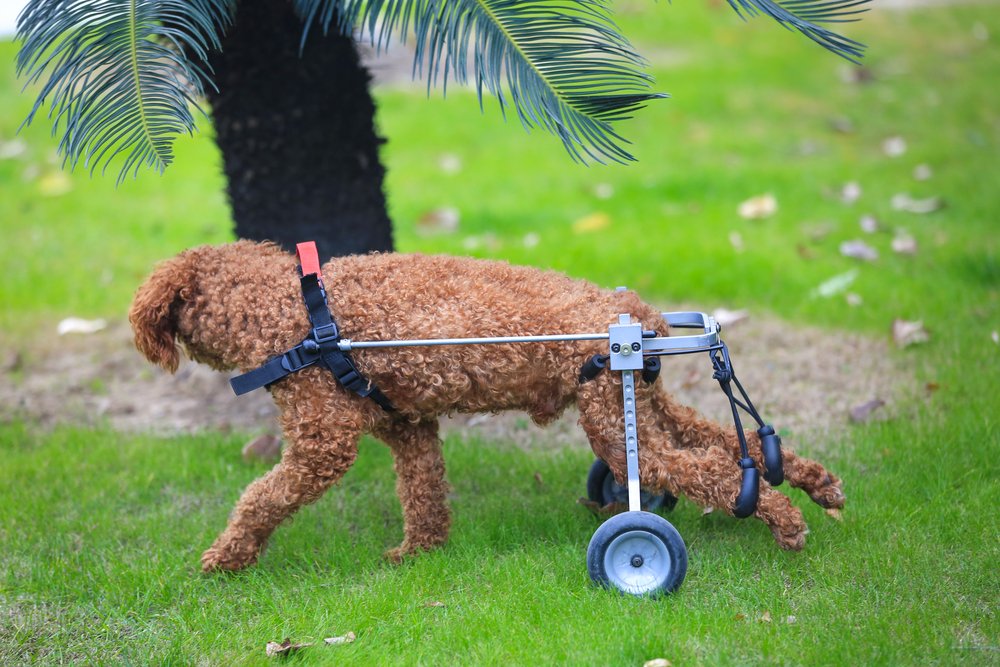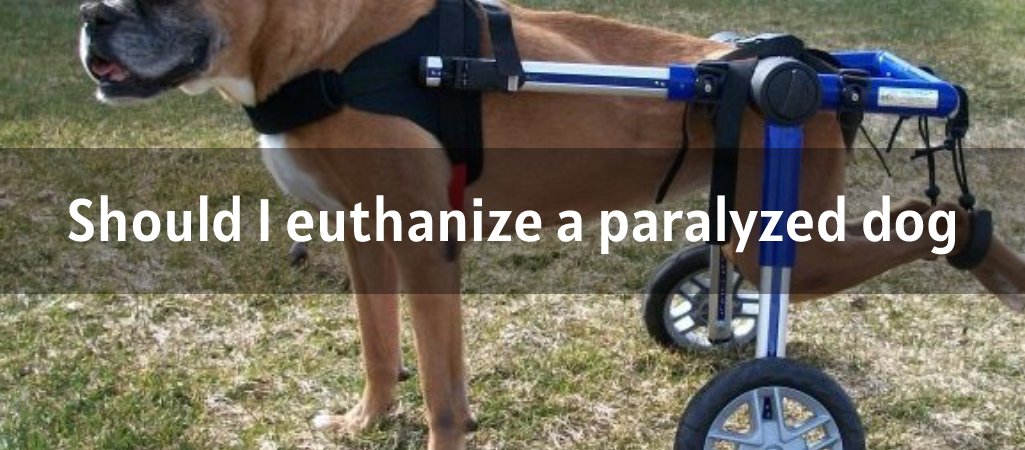Paralyzed dogs are only considered for euthanasia when all other options, such as physical therapy, wheelchair use, laser therapy, surgery, or other treatments, have been tried.
The disabled dog is either in too much discomfort or has a poor quality of life for it to continue to live.
Veterinarians use the term “euthanasia” to refer to the humane end of an animal’s life to end or avoid needless suffering caused by an incurable medical condition.

What is paralysis in dogs?
A dog is declared paralyzed if one or more limbs are completely immobile.
Paralysis in a dog usually results from a disruption in signals traveling between the spinal cord and the brain. In severe situations, the dog will be completely paralyzed and unable to move its legs.
Whereas in milder cases, the brain and nerves of the spinal cord may still be able to communicate, the dog will seem feeble and have trouble moving its legs; this is known as paresis or partial paralysis.
Sometimes a dog will lose the use of all four legs (a condition known as tetraplegia), while other times, it will regain some mobility in some of its legs but not others. Paralysis always depends on the type of injury to the brain, spine, nerves, or muscles.
Sudden paralysis in dogs can occur for a variety of causes, including age-related illnesses like arthritis, injuries, trauma, intervertebral disc disease, disc rupture, fibrocartilaginous embolism (FCE), also known as spinal stroke, severe accidents like falls or abuse, cancerous growth in the spinal cord that can cause sudden paralysis or other cases such as intervertebral disc disease or degenerative myopathy.
Although these disorders are not mutually restrictive, they all have one thing in common: spinal cord damage or injury.
Treatment for paralyzed dogs
Paralyzed dogs require particular attention. The level of care needed is proportional to the severity of the dog’s paralysis. They can lead a normal lifestyle with the proper care and attention. The level of care required is proportionate to the severity of the dog’s paralysis.
Your veterinarian is the greatest provider of care-related information. A typical treatment for handicapped dogs usually includes play-and-go exercises, physical therapy, surgery, and assisted devices such as a wheelchair, as well as home care for the bladder and bowel.
The good news is that paralysis does not need a decision to end life. Euthanization is unnecessary if your dog is doing well and progressing with recovery.
When does it become a concern?
Various symptoms, from minor instability or poor coordination to complete paralysis or damaged spinal cord, may accompany this condition, and the recovery usually takes a few weeks.
But it becomes a concern when it starts to limit the mobility of paralyzed dogs and affect the quality of their lives. With limited mobility, recovery usually takes a lot of work.
What does it mean for my dog to be euthanized with paralysis?

Euthanizing a dog with paralysis means you want your vet to put your dog to sleep so it can end the pet’s pain and suffering. Euthanizing may be considered if your dog is in extreme pain or has a severe medical condition that severely limits its quality of life.
Considering euthanizing a paralyzed dog is rarely a pleasant idea. However, if a dog is terminally ill, euthanasia may be the kindest option. Furthermore, you won’t have to weigh all the pros and cons on your own; your vet will be there to guide you.
Should I euthanize a paralyzed dog?
Since only you and your physician can answer this question, there have been tremendous changes in how veterinarians evaluate paralysis and the quality of life of dogs.
Assessing the quality of life of your dog is complicated. Most pet owners are instructed to look for basic signs, such as discomfort or when their dog stops eating.
Quality of life assessment for euthanasia
Veterinary professionals have come up with a scale of quality of life. The scale consists of two parts: a tailored evaluation of the quality of life your pet is experiencing and an assessment of the problems the human family members are encountering.
There are four types of questions that pet owners or any family member should respond to and rate:
- Social behavior: does the pet enjoys being with its owners?
- Physical health: any signs of pain or anxiety.
- Mental health: similar likes or dislikes as before the injury.
- Basic body functions: is he able to pee or poop, or eat independently?
The mechanism of scoring lies between 0 and 2.
If your dog scored eight or less, it suggests they did the behavior naturally. Quality of life is doubtful between the 9th and 16th points, at which point medical evaluation is suggested.
If you scored between 17 and 36, there is an issue with your quality of life.
Consequently, family members react to the same things that a pet does that concern them.
The scoring mechanism for this scale also ranges from 0 to 2. Instead of evaluating their dog’s behavior based on broad categories, pet owners respond to and are scored on particular remarks.
A score of 0 indicates, “I am not currently concerned about this conduct.” A score of 1 indicates some concern about the conduct, whereas a score of 2 indicates a significant problem.
Signs for euthanizing a handicapped dog
The following are signs that it may be time to contemplate euthanasia for your dog:
- Constant weakness or paralysis of limbs.
- Dragging limbs.
- Only eating when compelled or none at all.
- Inability to control their bladder/ constantly eliminating on their own.
- Can’t walk without help.
- Can’t move up and down on their own.
- Constant whimpering
- They no longer appear joyful.
Veterinary professionals may also recommend euthanasia if your dog is in the latter stages of a life-threatening illness, such as:
- Chronic heart failure
- Uncurable or very malignant tumors, such as hemangiosarcoma
- Tracheal rupture
- Cushing disease
It has been studied that dogs with spinal cord injuries who still cannot recover from pain after three weeks are often euthanized for the poor prognosis they face.
The best way to euthanize a dog
When a dog is too old or sick to have “sound health” or the capacity to enjoy life, veterinarians may prescribe euthanasia. Consider euthanasia if your dog is in constant discomfort, old, and can no longer stand or walk.
Places where euthanasia can be performed, include the pet parent’s house, the veterinary clinic, and the animal hospital.
To ensure your dog’s comfort, your veterinarian will typically provide a sedative injection that causes them to lose consciousness. It has an immediate impact, generally in 30 seconds or less, and causes your dog’s heart to cease pumping. They will next administer a final dosage of sodium pentobarbital.
Your dog will go to sleep calmly and feel nothing.
Vet advice on euthanasia
This video shows that Dr. Jones advises when it may be appropriate to euthanize your dog or cat. The footage begins at 40 seconds, and he suggests using a quality of life scale to rule out the criteria for euthanizing a pet and what pet owners should follow to see what’s best for their pets.
Lauren Carey gives her opinion as a veterinarian; she can guarantee that pet owners choose to euthanize paralyzed animals for reasons like paralysis or any internal disease. She also genuinely endorsed and advocated such decisions. It’s a matter of quality of life for both pet parents and dogs with paralysis. Therefore, choosing euthanasia rather than continuing to fight is a humane act.
Amber Larock, a vet emergency technician, explains when we should consider euthanizing handicapped dogs.
This video shows Dr. Lorraine telling us how one can euthanize a dog at home.
Experience from pet owners

Rachael Bateman, a paralyzed dog owner, shares her opinion about this matter, as she believes that euthanasia should always be determined by what is best for the animal. It should not be done carelessly. Still, it is occasionally the kindest and most viable alternative. She wouldn’t want to be euthanized for a broken limb since it’s fixable, but she might if she was dying and in excruciating pain with little chance of recovery.
Another disabled dog owner, Cecelia, said her veterinarian prescribed anti-inflammatory drugs and resting Kennel while they waited to see if he would heal without surgery. If she’s comfortable, wait a few days to reassess. Spending those extra days with her dog and observing his declining quality of life reinforced her decision to let him go.
Conclusion
The decision of whether or not to euthanize a paralyzed dog is tough. It may be both emotionally and financially demanding. Euthanasia can alleviate pain and suffering, but it entails the loss of a valued pet or dog.
Before making the final choice, it’s essential to consider all possible options and carefully weigh the pros and cons. This includes talking to a vet, researching treatments, and talking to family members about the pet’s quality of life.
Before you go
Studies indicate that pet owners are less likely to be depressed than those without pets, even if the owner has a disability. Please read our article here about how pets can be helpful to paralyzed owners.

